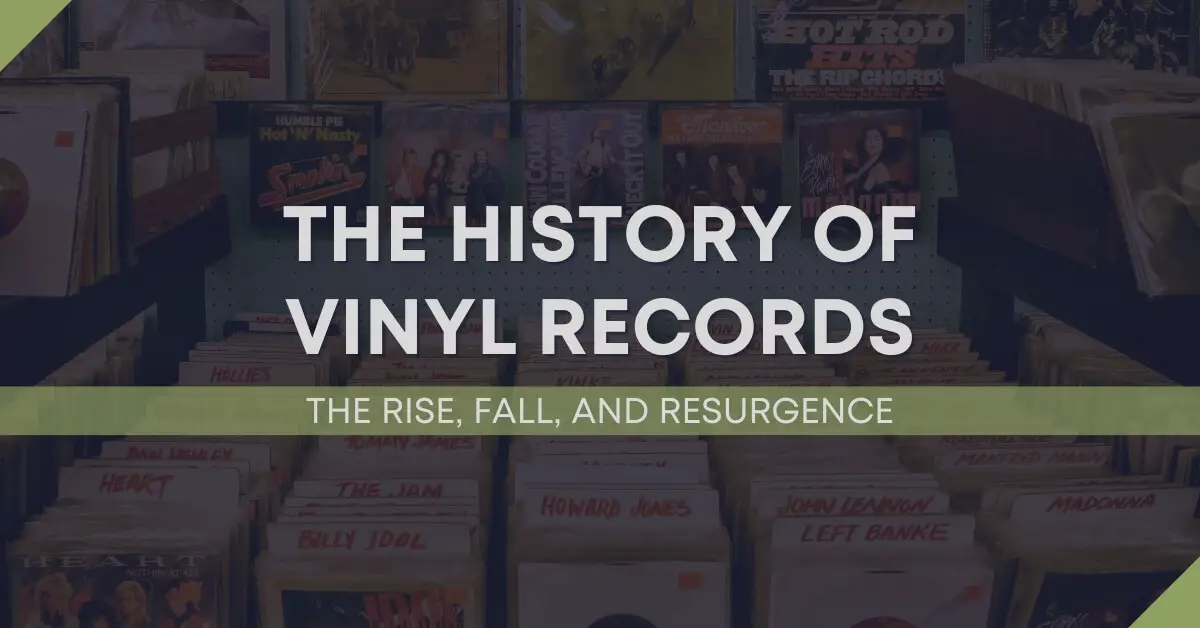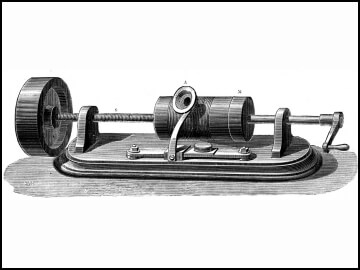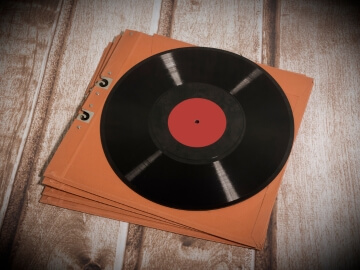
Vinyl records, with their unmistakable grooves and iconic covers, have etched an indelible mark on the timeline of music history. These flat, circular discs, which once dominated the music industry, represent more than just a medium for sound. They encapsulate entire eras, cultural movements, and the essence of generations.
While the digital age introduced more convenient ways to consume music, the allure of vinyl records remains undiminished. Their rich, warm analog sound has ensured that they're not just relics of the past as they continue to resonate with both vintage enthusiasts and the modern generation.
As we delve into the history of vinyl records, we'll journey through their birth, golden age, challenges, and their remarkable resurgence in the 21st century. So, sit back and prepare for a blast from the past!
The history of vinyl records, from their conceptualization to their widespread adoption, is a tale of innovation, challenges, and cultural shifts. As we trace back to the origins, we find a landscape of evolving technologies and changing preferences that paved the way for vinyl's eventual dominance.

Before the inception of vinyl records, the world of recorded sound was dominated by phonograph cylinders, invented by Thomas Edison in the late 19th century. These cylindrical objects played sound when rotated under a stylus, but they had limitations in terms of storage capacity and durability. The quest for a more practical solution led to the creation of flat disc records. Initially, these discs were made from shellac—a material derived from insect secretions mixed with slate dust. Although an improvement, shellac records were brittle and prone to breaking.

The year 1948 marked a significant turning point in the history of recorded music. Columbia Records led the charge and introduced the Long Play (LP) record, spinning at 33 1/3 revolutions per minute (rpm). These new records were made from a material called vinyl, a type of plastic that was more flexible and durable than shellac. Vinyl's superior properties allowed for longer playtimes, typically up to 22 minutes per side, a vast improvement over the previous limit of around 5 minutes on 78 rpm shellac discs.
But the advantages of vinyl didn't end with its durability and capacity. It also offered a richer, more nuanced sound quality. The finer grooves of the vinyl LP could reproduce a wider range of frequencies, capturing the intricacies of musical recordings in greater detail. This innovation was not just a technical achievement; it transformed the way artists thought about albums. With more time available, they could craft cohesive, extended musical narratives, paving the way for concept albums and the album era of the 1960s and 1970s.
The introduction of the vinyl LP was a game-changer, setting the stage for the golden age of vinyl records and revolutionizing the way people experienced music.
The post-war era, marked by social, cultural, and technological changes, set the stage for vinyl records to truly shine. As the 1960s dawned, the world was on the cusp of a musical revolution, with vinyl records at its heart. This period, stretching through the 1980s, is often regarded as the golden age of vinyl, where the medium became synonymous with music itself.
Rock 'n' Roll, with its rebellious spirit and electrifying rhythms, found its perfect partner in vinyl records. The 1960s and 1970s saw legendary bands and artists release iconic albums, with the Beatles, Rolling Stones, Pink Floyd, and Led Zeppelin leading the charge. These records, often pressed in vinyl, became cultural artifacts, treasured by fans and collectors alike. The tangible nature of vinyl allowed listeners to engage with music on a deeper level, poring over intricate album artwork, reading liner notes, and experiencing the ritual of placing the needle onto the record.
The vinyl era also heralded the rise of album artwork as an essential component of the musical experience. Album covers evolved from mere protective sleeves into canvases for artistic expression. Iconic designs, such as Pink Floyd's "Dark Side of the Moon" or The Beatles' "Sgt. Pepper's Lonely Hearts Club Band," became ingrained in popular culture. These covers not only visually represented the music within but also shaped the identity of bands and the zeitgeist of the times. As vinyl sales soared, the synergy between music and art deepened, making the two inseparable in the minds of listeners.

As the 1980s progressed, the music industry underwent another transformation. New formats emerged, promising portability and convenience, which posed a significant challenge to the dominance of vinyl records. While vinyl had enjoyed decades of unrivaled supremacy, the winds of change were beginning to stir, signaling a shift in how people consumed music.
The introduction of the Walkman in the late 1970s marked the beginning of the portable music era. Cassettes, with their compact size and rewind/fast-forward capabilities, became the preferred medium for on-the-go music lovers. The sound quality debate raged on, with purists championing the warmth and depth of vinyl, while many consumers were drawn to the convenience and functionality of cassettes.
The 1980s also saw the birth of the Compact Disc (CD). CDs offered a digital clarity and skip-free listening experience that was touted as superior to the analog sound of vinyl. Their durability and capacity to hold more music than vinyl LPs made them an attractive option for many. As CD players became more affordable and widespread, the number of vinyl records sold declined.
The rapid adoption of cassettes and CDs dealt a blow to the vinyl industry. Record stores started dedicating more shelf space to these newer formats, and vinyl pressings reduced dramatically. By the early 1990s, many believed that vinyl was on the verge of extinction, relegated to the annals of history. However, a niche market of audiophiles and collectors remained steadfast in their loyalty to the format, keeping the spirit of vinyl alive even in its darkest days.
While the late 20th century was the worse time in the history of vinyl records, the turn of the millennium brought with it a surprising twist in the tale. As the digital age surged forward, a counter-movement began to take shape. A renewed interest in the analog experience of music sparked a revival of vinyl. This resurgence wasn't just a fleeting trend but a testament to vinyl's enduring appeal in an increasingly digital world.
Collectors and audiophiles, driven by a passion for the authentic sound and nature of vinyl, played a significant role in its comeback. Limited edition pressings, colored vinyl, and special releases became highly sought-after items, often fetching high prices on the secondary market. Beyond the pure sound quality, the act of collecting vinyl records became a hobby and a statement of one's musical identity. The large album covers, complete with intricate artwork and liner notes, offered a sensory experience that digital formats couldn't replicate.
Contemporary musicians, recognizing the unique value of vinyl, began releasing their albums on this classic format. From indie bands to mainstream artists, many chose to offer vinyl editions alongside digital releases. Record Store Day, an annual event celebrating the culture of independent record stores, further fueled the vinyl revival, with exclusive releases and special performances drawing crowds worldwide. This renewed interest bridged generational gaps, as both older fans and a new generation discovered the magic of vinyl together.
The term "vinyl" refers to the primary material used to make these records. Vinyl, a type of plastic known for its durability and flexibility, replaced earlier materials like shellac to become the standard for record production.
This is a subject of much debate among audiophiles. Vinyl enthusiasts often praise the warmth and depth of analog sound, valuing the subtle imperfections that give each record a unique character. Digital formats, on the other hand, offer precision and clarity. Ultimately, which format has better sound quality is subjective and depends on individual preference.
Vinyl records can be more expensive than digital downloads or streaming due to the costs associated with production, packaging, and distribution. However, many collectors and enthusiasts see vinyl as a valuable investment, not just for the music but also for the tangible artwork and overall experience.
It's essential to handle records by their edges, avoid touching the grooves, and store them vertically in a cool, dry place. Regularly cleaning records with a soft brush or specialized cleaning solution can also help maintain sound quality and prolong their lifespan.
Throughout the history of vinyl records, these magical discs have shown to be more than just a fleeting trend. The enduring appeal of vinyl, from its sound quality to its experience, suggests that it will continue to hold a special place in the world of music for years to come.
Vinyl records, with their tactile charm and ritualistic experience, offer a respite from the instant gratification of the digital age. The act of handling a record, from its sleeve to the needle's descent, creates a profound connection between the listener and the music. This physical interaction, combined with the analog warmth and depth of vinyl's sound, delivers an organic and immersive auditory journey distinct from digital precision.
Beyond just sound, vinyl serves as a cultural artifact. Album covers, grand canvases of artistic expression, not only visually represent the music but also weave stories and context. These intricate designs and liner notes become conversation starters, encapsulating moments in time and resonating with memories of youth, discovery, and nostalgia.
In a world dominated by digitization, the resurgence of vinyl underscores the value of tangibility and the essence of savoring every note. It's not just a nod to the past but a testament to vinyl's timeless ability to connect, inspire, and endure in the hearts of music lovers.
"Some of the links within this article are affiliate links. These links are from various companies such as Amazon. This means if you click on any of these links and purchase the item or service, I will receive an affiliate commission. This is at no cost to you and the money gets invested back into Audio Sorcerer LLC."